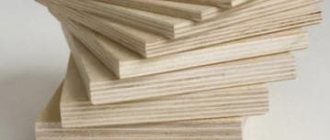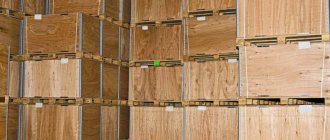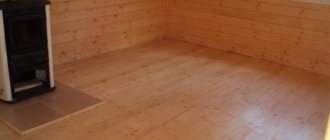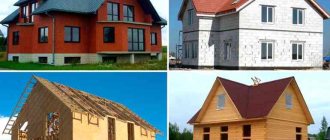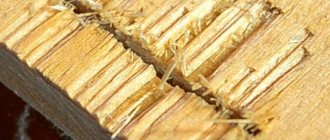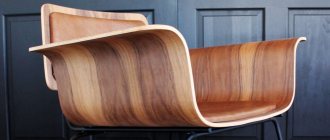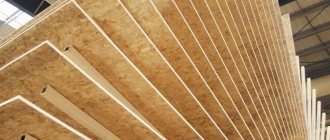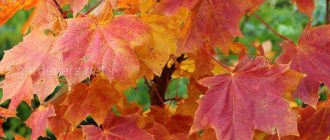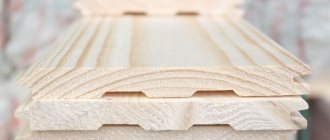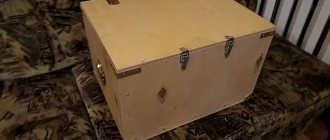Formaldehyde in plywood
Formaldehyde is the simplest substance from the group of aldehydes. Upon direct contact, it irritates the skin and mucous membranes, and if ingested, it affects the nervous system. Its maximum permissible concentration (MPC) in the air is 0.5 mg/m3. If the concentration of formaldehyde exceeds these values, a person’s well-being may worsen. The lethal dose is 60-90 ml, taken orally once. This corresponds to about 50-70 g of substance based on weight.
So is plywood harmful to humans if it contains urea or phenol-formaldehyde resins? To answer this question, you need to know how much formaldehyde is included in its composition. Depending on the content of this substance, plywood sheets are divided into the following emission classes:
- E0 – formaldehyde is completely absent, and therefore it is not released into the air in any quantities. This kind of plywood is not produced in Russia, but this emission class exists in the USA.
- E1 – 100 g of plywood products contain up to 10 mg of formaldehyde. This includes FC, FBA and FBV plywood, which you can buy from us at a low price with delivery throughout Moscow and Moscow Region. When these sheets are kept indoors, no more than 0.124 mg of formaldehyde is released into each m3 of air.
- E2 - 100 g of material contains from 10 to 30 mg of formaldehyde, and more than 0.124 mg of this substance is released into the air per m3. This includes sheets FSF, FBS and FOF. Our warehouse always stocks these brands of plywood with an attractive price, as well as a large assortment of formats and thicknesses.
- E3 – 100 g of material contains 30-60 mg of formaldehyde. The production of such plywood is prohibited due to its high toxicity.
The safest plywood in Russia is produced by Syktyvkar Plywood Plant LLC. It produces products with emission class E0.5, which fully complies with European standards. 100 g of such material contains up to 2.4 mg of formaldehyde.
Plywood as it is, or is everything so simple with plywood
Do you think that such material differs only in the type of wood veneer? Not at all! Equally important is the quality of the wood and the type of binder used as glue for the veneer layers. The following characteristics of plywood depend on these three parameters:
- moisture resistance;
- weight;
- environmental friendliness;
- durability and strength;
- price.
To order exactly the plywood that fully meets the necessary requirements (including cost), you need to understand what each letter in the marking means. The table below shows the brands of this material and the characteristics of each of them:
| Brand | Description |
| FBK | In this kind of plywood, the veneer sheets are glued together with bakelite varnish – a binder that is resistant to moisture and temperature fluctuations. As a result, FBK can be used in outdoor work in any climate zone. In addition, material of this brand is legitimately used when installing formwork. And, of course, non-hygroscopic FBK plywood is an excellent material for building boats and yachts. |
| FBS | In this material, the veneer is treated with alcohol-soluble bakelite glue. As a result, bakelized FBS plywood becomes particularly resistant to moisture. It has the following properties:
FBS grade plywood is called aviation plywood (at the dawn of aircraft manufacturing it was used in the construction of airplanes). In addition, it is still used today in shipbuilding. But due to its high cost, this material is not in demand in construction. |
| BV | This type of plywood is also made using bakelite adhesives. But this brand is obtained using water-soluble adhesive materials. As a result, plywood sheets are afraid of moisture, but have decent strength. |
| FC | In this brand of plywood, the veneer is subjected to special treatment. Before pressing, it is coated with a carbide mixture. FC is the most popular brand. It is used in construction and furniture production. This material is inexpensive, but quite durable and environmentally friendly. True, such slabs are not suitable for outdoor use - they do not have the necessary water resistance. |
| FBA | In this brand, veneer sheets are glued together using natural albumin-casein adhesives. Therefore, such plywood is considered the most environmentally friendly. Although it does not tolerate moisture at all. |
| FSF | In this material, veneer is glued together with phenol-formaldehyde resins. The FSF grade of plywood has high levels of moisture resistance, wear resistance and strength. But the environmental friendliness of this plywood leaves much to be desired. Therefore, this material is ideal for outdoor construction work. |
To summarize, we note that for internal construction work, plywood for the FC floor is best suited. For external ones, use moisture-resistant brands.
Plywood sheets impregnated with PVA glue become anti-hygroscopic for a long time. Therefore, for outdoor work, you can buy the FC brand and treat each of them with this glue.
To choose the right plywood, remember the moisture-resistant brands:
- FBK;
- FBS;
- FSF.
What is known about phenol
Phenol is a derivative of benzene. This is a toxic substance for humans, which, when ingested, affects the visual center and central nervous system. The lethal dose for humans is 5-10 g, and the MPC is 1 mg/m3 of air. Does this mean that phenol-containing plywood is dangerous?
Only waterproof types of plywood contain phenol - FSF, FOF, FBV and FBS. But it makes up only 11% of the total mass of resin used to glue the veneer. Everything else is formaldehyde. In this regard, phenol does not have a significant effect on human health. But as a precaution, materials containing this substance are not recommended for interior decoration.
Plywood grade FSF E1 produced by: Tavdinsky Plywood and Board Plant LLC
Brand: FSF E1 GOST No.: 3916.1-96 Size, mm: 1525x1525 Thickness, mm: 3, 4, 5, 6, 8, 10, 11, 12, 15, 18, 20, 21, 25, 24, 27, 30 , 35, 40 Grade: I/II, II/II, II/III, II/IV, III/IV, IV/IV.
Birch plywood is produced, Emission class E-1, Sanded on 2 sides, except for grade IV/IV and from a thickness of 21 mm.
Birch plywood of the FSF brand is a high-quality construction material with high strength and increased moisture resistance. Thanks to the use of special glue, FSF brand plywood retains its performance properties in conditions of high humidity, does not deform, and does not get wet. FSF brand plywood is used in both interior and exterior work.
Based on the degree of water resistance, plywood is classified into two classes:
waterproof plywood grade FK;
FSF grade plywood with increased water resistance.
Moisture-resistant plywood FSF, like other plywood products, is based on an odd number of veneer sheets, which are glued together using a special phenol-formaldehyde adhesive resin.
Moisture-resistant plywood FSF:
To make waterproof plywood, veneer made from birch or thin softwood is used. This type of plywood is produced by gluing veneer at high temperatures under pressure. As a result, layers are formed, which are further cooled, marked and then, after a short period of maturation, collected into packages of 10 or 20 pieces.
FSF brand plywood has high tensile and bending strength, reliability and durability. Sheets of waterproof plywood have increased moisture resistance, which allows the product to be used for outdoor use.
Moisture-resistant waterproof plywood of the FSF brand:
Today, moisture-resistant FSF plywood is the most common finishing material. It is used not only in the manufacture of furniture and construction, but also in the car and automotive industries, when carrying out roofing work, for laying flooring and for the manufacture of packaging and containers, as well as advertising boards. This demand is due to the numerous and undoubted advantages of this type of plywood. It is easy to process. It is easy to drill, saw and fasten with both screws and nails.
Advantages:
• 100% birch veneer • Increased moisture resistance • Exceptional strength and wear resistance • Surface hardness • Unique ability to withstand heavy loads • Resistance to temperature changes: from -40 to +50 ° C • Wide selection of thicknesses and sizes
Application:
- Construction
- Transport
- Furniture
- Package
- Other
Specifications:
| · Format *, length x width, mm (ft): | 1220x2440x1220 (4x8x4) 1250x2500x1250 (4x8x4) 1500/1525x2500 (5x8) 1500/1525x3000/3050 (5x10) |
| · Thickness, mm: | 4-40 |
| · Plywood grade: | I (B, S), II (BB), III (CP), IV (C) |
| · Surface quality: | Sanded (S2S), sanded on one side (S1S), unsanded (NS) |
| · Formaldehyde emission class: | E1 |
| · Water resistance: | Increased |
| · Density, kg/m3: | 640-700 |
| · Humidity, %: | 5-10 |
Strength indicators:
| · Tensile strength, MPa, not less: | when chipping along the adhesive layer | 1,5 |
| with static bending along the fibers of the outer layers | 25 | |
| when stretched along the fibers | 30 | |
| · Modulus of elasticity, MPa, not less than: | with static bending along the fibers | 7000 |
What is more harmful: FC or FSF
Many people are interested in which plywood is less harmful: FC or FSF. To answer this question, let's look at the information discussed above. Based on this, we draw three conclusions:
- The harm of FC plywood is less, since it contains only one of the dangerous components - formaldehyde.
- There are more harmful emissions from FSF plywood, since it contains both formaldehyde and phenol.
- The harm from FSF plywood is higher, since it belongs to the second emission class - E2.
That is why it is recommended to use only FC plywood in interior spaces. FSF and FOF sheets are intended for external use. This is due to the fact that in open space toxic compounds immediately evaporate and cannot cause harm to humans. Using plywood according to the recommendations, you will not harm yourself or your loved ones.
Specifications
The operational features of plywood are largely determined by the variety.
Density and strength
These parameters depend on the raw materials, gluing technology and the number of veneer layers.
Sheet products have the following parameters:
- Density. The standard provides for variation from 300 to 1000 kg/m3. Standard products have values of 550–750 kg/m3, FB boards can reach 120 kg/m3.
- Strength. It is determined by the chipping limit indicators and depends on the type of veneer and the type of glue, but not less than 0.9 MPa.
The density and strength of the sheet are especially important when constructing loaded structures, but during installation it should be taken into account that the higher the density, the greater the weight of the material
Flammability
Like all wood materials, plywood is a fire hazardous product, which corresponds to class KM-3.4 and requires special conditions of use. The slabs ignite at a temperature of 270 degrees, spontaneous combustion begins at 400°C.
The resistance of the sheets depends on the thickness: 18 mm birch panels can withstand flames for 15 minutes. At the beginning of combustion, charring is 0.8–1.2 mm per minute.
To improve performance, special types of impregnation and processing are used. There are also fire-resistant products that have a longer ignition period.
Moisture resistance
The degree of moisture resistance depends on the glue used:
- FBA is subject to delamination at high humidity and short-term exposure to water.
- FC is resistant to contact with liquid for several hours and is subsequently subject to deformation.
- FSF is able to withstand direct contact for a long time, and after drying it retains part of the structure.
- Bakelized varieties are even resistant to sea water. The exception is products impregnated with a water-based composition.
With additional processing, the resistance to any variation increases significantly.
Eco-friendly plywood
Environmental friendliness is one of the key requirements that modern consumers place on building materials. This is a guarantee of good health for all residents, a guarantee of safety and absence of harm to health. Unfortunately, when producing blanks, environmental friendliness is not in the first place, which is why buyers often suffer. This is especially unpleasant when it comes to using plywood in a children's room, where any harmful effects can affect a fragile little body.
The safety principles of building materials are classified as follows:
- Chemical. According to it, materials that are allowed to be used indoors must not emit toxins.
- Firefighter: the workpieces must be safe from this point of view.
- Biological. It involves treating workpieces with safe antiseptic solutions that prevent the spread of mold and mildew.
- Physical - implies compliance of all elements with heat and sound insulation standards.
What criteria are important to follow when choosing
If you need to choose plywood for your floor among a wide variety of materials, you should pay attention to the following aspects:
- marking (only FC is suitable for living rooms);
- grade (the material is available in 4 grades: for rough coating you can take 3 and 4, for finishing you need to take 1 or 2 grades);
- class (for flooring only plywood of class E-1 is allowed;
- humidity (the quality of the sheets will depend on this, % should not exceed 12-15%);
- the number of layers in the sheet (the level of strength depends on it, but the thickness of the material should be chosen depending on its purpose: sheets of 12-18 mm are taken for the subfloor, and 10-12 mm for the front floor);
- sheet sizes (format and large-format plywood are produced, sheet parameters are prescribed in GOST 3916.1-96 and 3916.2;
- manufacturer (high-quality plywood, according to experts, is produced by European and domestic enterprises, while Chinese ones often do not meet the declared characteristics.
Attention!!! It is important to remember that plywood is not suitable for buildings with significant temperature changes (country houses, premises for temporary residence). This also applies to rooms with a high percentage of humidity (bathrooms, baths, saunas, swimming pools, etc.).
Which plywood is suitable for joist floors
Before you start arranging plywood floors along the joists, you should clearly understand what kind of floor you need to make: rough or finished. It is necessary to select a material taking into account the following parameters:
- Base type . Concrete has high thermal conductivity; sheets with a thickness of 15 mm or more can reduce heat loss. And the thickness of the plywood for the floor along the joists, if this is a rough version, is 12 mm.
- Type of premises . For residential use, the FK variety is recommended; it is the most environmentally friendly.
- Sheet thickness . If plywood needs to be laid on joists, it is necessary to correctly determine the thickness of the disc; the service life of the subfloor depends on it. But here it is important not to go too far: the thicker the board, the greater the mass of the flooring, and this is an additional load on the joist structure.
Important! When choosing the thickness of the sheets, craftsmen are guided by the pitch (the distance between the lags). With cell parameters of 0.5-0.6 m, sheets will be needed with a thickness of 15 mm.
What is the advantage of using plywood sheets for flooring?
There are many advantages to using plywood for flooring:
- environmental friendliness (made from natural raw materials, not wood waste);
- has a humidity level ranging from 12% to 15%;
- makes good contact with all types of floor coverings, extending their service life;
- does not require special preparation for installation, can be installed in stages;
- performs the function of insulation (reduces heat loss through the screed and floor panels);
- is an ideal option for leveling large differences in height across the floor, when it is not possible to use a screed due to an increase in the load on the floor;
- allows you to arrange floors in accordance with specified parameters at minimal cost;
- used for arranging all types of floors (selected according to the quality of polishing).
Bottom line
You can now easily choose plywood taking into account all the necessary parameters for leveling and insulating floors, since you know its advantages and disadvantages, methods of installation on different surfaces and in different rooms. And professional advice will help you avoid common mistakes in choosing material for plywood flooring. Correctly selected simple and affordable finishing material will allow you to enjoy the result for a long time.
A little more attention!
Write in the comments what you think - is wood in the interior a classic, or already a thing of the past?
Features of plywood grade 4 4
Among most consumers, plywood grade 4 4 is in great demand today, what does this mean and what was the reason for this? First of all, its low cost and excellent performance characteristics. This material is distinguished by high quality of connection of layers and an unpolished surface (contains many defects), so it is used only for the manufacture of packaging products and containers. Suitable for laying subfloors and as a base under carpet and other finishing coverings.
Technical parameters of sheets:
- sheet size 1500x1500 mm;
- canvas thickness – 8 mm;
- deviation in width/length – within 2 mm;
- IV grade.
